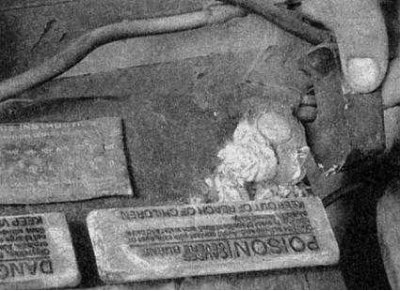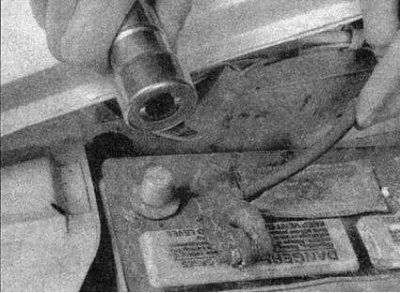
Tools and materials needed to care for the battery.
- 1 - Face shield / goggles - when brushing off traces of corrosion, particles of crystallized acid can easily get into the eyes
- 2 - Baking soda - an aqueous solution of baking soda can be used to neutralize corrosion
- 3 - Acid-free vaseline - a layer of vaseline applied to the battery terminals will help prevent corrosion
- 4 - Terminal/Wire Lug Stripper - This wire brush tool will remove all traces of corrosion from battery terminals and wire lugs
- 5 - Impregnated felt washers - installing such washers on each battery terminal directly under the wire lugs will help to avoid corrosion
- 6 - Puller - sometimes the wire ends are very difficult to remove from the battery terminals, even after completely loosening the nuts / bolts. This tool will help remove the tips vertically upwards without damage
- 7 - Terminal/wire stripper - another type of stripping tool, a slightly modified version of point 4 that performs the same functions
- 8 - Rubber gloves - another means of protection when working with a battery; remember that the battery contains acid!
Check and care
Warning! Certain safety precautions must be taken when working with the battery. Highly flammable hydrogen is always present in battery cells, so never approach a battery with a lit cigarette or other open flames. Battery electrolyte is a solution of sulfuric acid, which can cause serious injury if splashed in the eyes or on exposed areas of the body. In addition, the acid corrodes clothes and paints. When disconnecting the battery, always disconnect the negative cable first and connect it last!
Caring for the battery is a very important procedure to avoid stops along the way due to its discharge. Several tools are required to complete the maintenance procedure.
1. Before starting a maintenance procedure, always turn off the engine and disconnect all electrical appliances first, then disconnect the negative cable from the battery.
Attention! If your car's radio is equipped with an anti-theft system, make sure you have entered the correct code before disconnecting the battery.
2. Normally, NISSAN vehicles are equipped with low maintenance batteries. You can remove the lids of the jars and add distilled water. The latest models can be equipped with batteries that do not require maintenance at all, which are completely sealed.
3. Remove the caps and check the electrolyte level in each of the battery cells. It should be above the plates. Usually there is a level indicator on each bank. If the electrolyte level is below normal, add only distilled water and then close the lids of the jars.

The electrolyte level should lie between the two lines on the outside of the battery case. The left arrow shows where the steel plate is inserted to remove the filler bar.

Checking the density of the electrolyte using a hydrometer.
Attention! Overfilling the jars can cause electrolyte to overflow during boost charging, causing corrosion and damage to components close to the battery.
4. If your vehicle's positive battery terminal and cable tie are equipped with a rubber protector, make sure it is not torn or damaged. It must completely cover the terminal.
5. It is necessary to periodically inspect the external condition of the battery for damage such as cracks in the case.
6. Check that the battery cable ties are securely tightened to ensure a good electrical connection. Check each of the wires along the entire length for cracks and fraying of the insulation and wires.
7. When traces of corrosion are found (usually a loose white coating) disconnect the wires from the terminals, clean them with a special brush and reconnect. Corrosion can be minimized by installing specially treated washers, available from auto parts stores, or by applying a coat of acid-free Vaseline or a suitable lubricant to the terminals and wire ties after they are connected.

Battery terminal corrosion usually appears as a light, fluffy powder.

Disconnecting the wire from the battery terminal with a wrench - sometimes, in cases where corrosion has destroyed the nut, special pliers are required for this procedure (always disconnect the ground wire first and connect it last!).

Regardless of the type of stripper, the result should always be a clean, shiny terminal surface.

When stripping wire lugs, all traces of corrosion must be removed (the inside of the tip has a taper that follows the shape of the battery terminal, so do not remove too much material).
8. Make sure the battery tray is in good condition and the clamp bolt is securely tightened. If the battery was removed from the pallet (see chapter Engine electrical system, describing the removal and installation procedure), make sure that there are no parts or other foreign objects on it during installation. When tightening the mounting collar, do not overtighten its bolt.
9. Traces of corrosion from the sump, battery case and surrounding surfaces can be removed with an aqueous solution of baking soda. Apply the mixture with a small brush, let it sit and then rinse with plenty of clean water.
10. Corroded metal surfaces of the vehicle should be primed with a zinc base and then painted.
11. Additional information about the battery and about starting the engine from an external source can be found in Chapter Engine electrical system and in Section Starting the engine from an auxiliary power source.
Charger
Note. Manufacturers recommend removing the battery from the vehicle to charge it, as the gas released during this procedure may damage painted surfaces or the interior of the vehicle, depending on the location of the battery. Rapid charging with the battery wires connected can damage the vehicle's electrical system.
1. Remove all caps from battery jars (if they exist) and cover the openings with a clean rag to prevent electrolyte splashing. Disconnect the negative battery cable and connect the charger wires to the battery terminals (positive to positive, negative to negative), then plug in the charger. If it has a switch, make sure it is set to «12 volt».
Attention! If your car's radio is equipped with an anti-theft system, make sure you have entered the correct code before disconnecting the battery.
2. If you are using a charger with more than two amps, check the battery regularly while charging to make sure it is not overheating. Using a slow charger, you can safely leave the battery charged overnight after checking regularly for the first two hours. Certain precautions may be required when charging maintenance-free batteries (e.g. using a very low current charger). This battery may have a warning label on it, but if it does not, consult your NISSAN dealer or electrician.
3. If the battery cells have removable lids, check the electrolyte density with a hydrometer every hour during the last few hours of the charge cycle. Inexpensive hydrometers are available from auto parts stores - follow the instructions provided when using them. The battery can be considered charged if within two hours the density of its electrolyte does not change, and the electrolyte itself in the banks bubbles freely. The density of the electrolyte in individual banks should be almost the same. If this is not the case, then one or more cells of the battery have failed and should be replaced.
4. Some maintenance-free batteries have a built-in hydrometer at the top with a window - a color indicator of the battery charge level. Usually, a brightly colored window means that the battery is fully charged, while a dark color indicates that additional charging is needed. For more specific instructions, see the battery manufacturer's instructions.
5. If the battery is sealed and does not have a built-in hydrometer, you can check the state of charge using a digital voltmeter connected to the battery terminals. A fully charged battery will show 12.6 or more volts.
6. More information about the battery and about starting the engine from an auxiliary source can be found in Chapter Engine electrical system and in Section Starting the engine from an auxiliary power source.